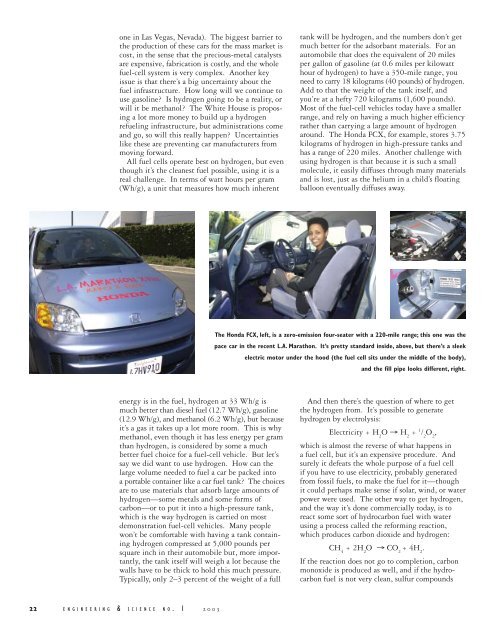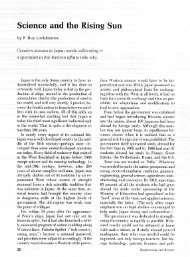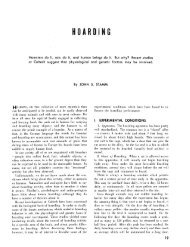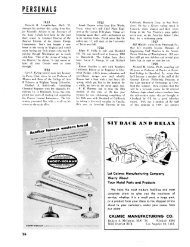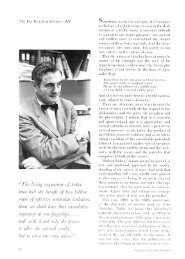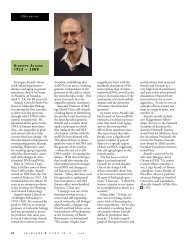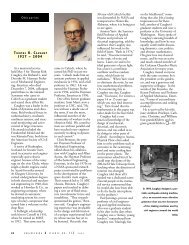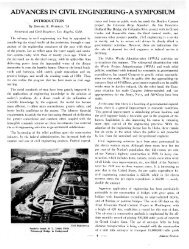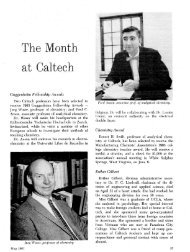indicates - Engineering & Science - California Institute of Technology
indicates - Engineering & Science - California Institute of Technology
indicates - Engineering & Science - California Institute of Technology
Create successful ePaper yourself
Turn your PDF publications into a flip-book with our unique Google optimized e-Paper software.
one in Las Vegas, Nevada). The biggest barrier to<br />
the production <strong>of</strong> these cars for the mass market is<br />
cost, in the sense that the precious-metal catalysts<br />
are expensive, fabrication is costly, and the whole<br />
fuel-cell system is very complex. Another key<br />
issue is that there’s a big uncertainty about the<br />
fuel infrastructure. How long will we continue to<br />
use gasoline? Is hydrogen going to be a reality, or<br />
will it be methanol? The White House is proposing<br />
a lot more money to build up a hydrogen<br />
refueling infrastructure, but administrations come<br />
and go, so will this really happen? Uncertainties<br />
like these are preventing car manufacturers from<br />
moving forward.<br />
All fuel cells operate best on hydrogen, but even<br />
though it’s the cleanest fuel possible, using it is a<br />
real challenge. In terms <strong>of</strong> watt hours per gram<br />
(Wh/g), a unit that measures how much inherent<br />
energy is in the fuel, hydrogen at 33 Wh/g is<br />
much better than diesel fuel (12.7 Wh/g), gasoline<br />
(12.9 Wh/g), and methanol (6.2 Wh/g), but because<br />
it’s a gas it takes up a lot more room. This is why<br />
methanol, even though it has less energy per gram<br />
than hydrogen, is considered by some a much<br />
better fuel choice for a fuel-cell vehicle. But let’s<br />
say we did want to use hydrogen. How can the<br />
large volume needed to fuel a car be packed into<br />
a portable container like a car fuel tank? The choices<br />
are to use materials that adsorb large amounts <strong>of</strong><br />
hydrogen—some metals and some forms <strong>of</strong><br />
carbon—or to put it into a high-pressure tank,<br />
which is the way hydrogen is carried on most<br />
demonstration fuel-cell vehicles. Many people<br />
won’t be comfortable with having a tank containing<br />
hydrogen compressed at 5,000 pounds per<br />
square inch in their automobile but, more importantly,<br />
the tank itself will weigh a lot because the<br />
walls have to be thick to hold this much pressure.<br />
Typically, only 2–3 percent <strong>of</strong> the weight <strong>of</strong> a full<br />
22 ENGINEERING & SCIENCE NO. 1 2003<br />
tank will be hydrogen, and the numbers don’t get<br />
much better for the adsorbant materials. For an<br />
automobile that does the equivalent <strong>of</strong> 20 miles<br />
per gallon <strong>of</strong> gasoline (at 0.6 miles per kilowatt<br />
hour <strong>of</strong> hydrogen) to have a 350-mile range, you<br />
need to carry 18 kilograms (40 pounds) <strong>of</strong> hydrogen.<br />
Add to that the weight <strong>of</strong> the tank itself, and<br />
you’re at a hefty 720 kilograms (1,600 pounds).<br />
Most <strong>of</strong> the fuel-cell vehicles today have a smaller<br />
range, and rely on having a much higher efficiency<br />
rather than carrying a large amount <strong>of</strong> hydrogen<br />
around. The Honda FCX, for example, stores 3.75<br />
kilograms <strong>of</strong> hydrogen in high-pressure tanks and<br />
has a range <strong>of</strong> 220 miles. Another challenge with<br />
using hydrogen is that because it is such a small<br />
molecule, it easily diffuses through many materials<br />
and is lost, just as the helium in a child’s floating<br />
balloon eventually diffuses away.<br />
The Honda FCX, left, is a zero-emission four-seater with a 220-mile range; this one was the<br />
pace car in the recent L.A. Marathon. It’s pretty standard inside, above, but there’s a sleek<br />
electric motor under the hood (the fuel cell sits under the middle <strong>of</strong> the body),<br />
and the fill pipe looks different, right.<br />
And then there’s the question <strong>of</strong> where to get<br />
the hydrogen from. It’s possible to generate<br />
hydrogen by electrolysis:<br />
Electricity + H O → H + 2 2 1 / O , 2 2<br />
which is almost the reverse <strong>of</strong> what happens in<br />
a fuel cell, but it’s an expensive procedure. And<br />
surely it defeats the whole purpose <strong>of</strong> a fuel cell<br />
if you have to use electricity, probably generated<br />
from fossil fuels, to make the fuel for it—though<br />
it could perhaps make sense if solar, wind, or water<br />
power were used. The other way to get hydrogen,<br />
and the way it’s done commercially today, is to<br />
react some sort <strong>of</strong> hydrocarbon fuel with water<br />
using a process called the reforming reaction,<br />
which produces carbon dioxide and hydrogen:<br />
CH + 2H O → CO + 4H .<br />
4 2 2 2<br />
If the reaction does not go to completion, carbon<br />
monoxide is produced as well, and if the hydrocarbon<br />
fuel is not very clean, sulfur compounds


